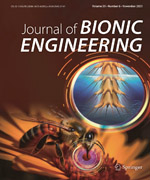|
|
Experimental Study on the Improvement of Yaw Stability by Coordination Control between the Caudal Fin and Anal Fin
Jiang Ding, Changzhen Zheng, Chaocheng Song, Qiyang Zuo, Yaohui Xu, Bingbing Dong, Jiaxu Cui, Kai He & Fengran Xie
Journal of Bionic Engineering
2022, 19 (5):
1261-1271.
DOI: 10.1007/s42235-022-00201-4
Due to the unique locomotion, the head-shaking problem of biomimetic robotic fish inevitably occurs during rectilinear locomotion, which strongly hinders its practical applications. In this paper, we experimentally study this problem by proposing the method of coordination control between the caudal fin and anal fin. First, an untethered biomimetic robotic fish, equipped with an anal fin, a caudal fin and two pectoral fins, is developed as the experimental platform. Second, a Central Pattern Generator (CPG)-based controller is used to coordinate the motions of the anal fin and caudal fin. Third, extensive experiments are conducted to explore different combinations of the flapping frequencies, the flapping amplitudes, and the phase differences between the anal fin and caudal fin. Notably, through proper control of the anal fin, the amplitude of the yaw motion can be as small as 4.32°, which sees a 65% improvement compared to the scenario without anal fin, and a 57% improvement compared to that with a stationary anal fin. This paper provides a novel way to alleviate the head-shaking problem for biomimetic robotic fish, and first test this method on an untethered, freely swimming robotic platform, which can shed light on the development of underwater robotics.
Related Articles |
Metrics
|
|



